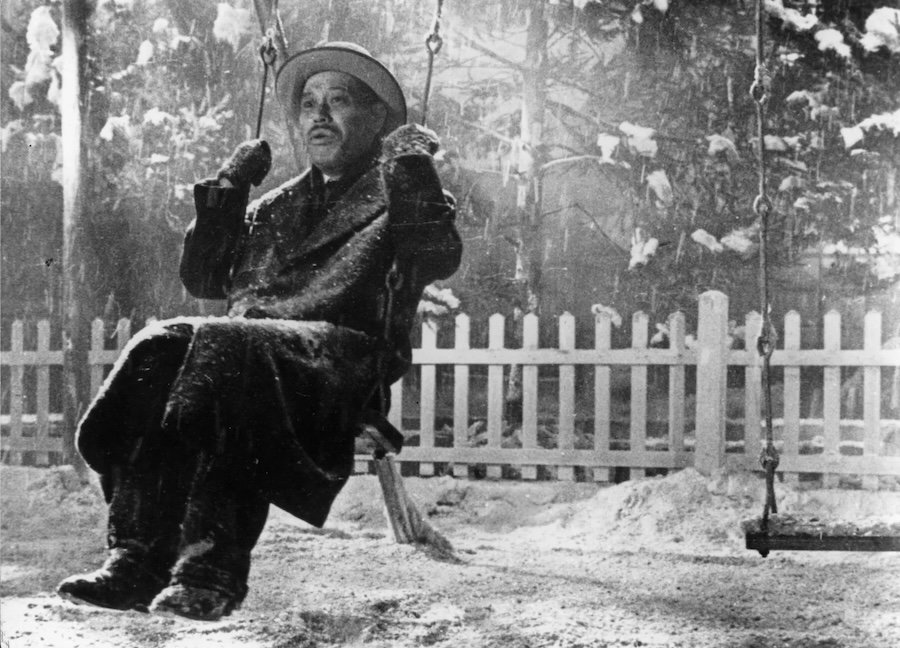
A BIG STORY OF A LITTLE MAN WHICH WILL GRIP YOUR SOUL…

Akira Kurosawa had a major international breakthrough with Rashomon in 1950, a historical drama. He then decided to make a film about life in Japan after World War II, hiring Shinobu Hashimoto and Hideo Oguni to write the screenplay. They were pretty much free to do what they wanted, as long as they made something out of Kurosawa’s basic idea, the story of a man who finds out that he only has a short time left to live. He also had a vision of the leading character on a swing and suggested the writers include a song from the 1910s or 1920s, ”Gondola no Uta”, where an older person warns the young of not wasting opportunities.
In the end, Kurosawa objected against the working title The Life of Kanji Watanabe and simply wanted Ikiru, which means ”to live”. Hashimoto, the less experienced of the two screenwriters, supported the idea. Oguni probably rolled his eyes, finding the title pretentious. But Ikiru it was, and the final results became one of Kurosawa’s most highly lauded.
Mastering the art of inefficiency
Kanji Watanabe (Takashi Shimura) is getting close to retirement after 30 years in the same job as a government bureaucrat. Along with his team, he has mastered the art of inefficiency, making sure that cases are handled correctly, but essentially shuffling them back and forth between various departments. His wife is dead and his relationship with his son and daughter-in-law, who live with him, isn’t great. Then he learns that he has cancer and won’t live much longer.
After failing to tell his son, who never really listens, Kanji decides to ignore his duties and head out into Tokyo’s nightlife together with a novelist he’s just met. Perhaps he’ll gain something deeper from getting to know Toyo (Miki Odagiri), a young woman who works for him…
A taste of his own medicine
Using this film as a tool (borrowing inspiration from a Tolstoy novella, ”The Death of Ivan Ilyich”), Kurosawa and his writers examined Japanese society after the war. Ikiru presents a far from positive portrait of the red tape and authoritarian attitude that dominate encounters between ordinary people and institutions. As a civil servant, Watanabe is very much a part of it, stacking piles of paper on top of each other and sending visitors off to other departments; as a patient, he gets a taste of his own medicine, as his doctor shares his professional sentiments. The whole system is like a machine that leaves no room for individualism or emotions, and this is what Kanji begins to reconsider when he learns that his life lacks meaning.
One of the important lessons we learn is that the old conservative notion of family as the ever-reliable answer to everything is false.
Ikiru shares similarities with Tokyo Story (1953), which also cast a critical eye on family life in Japan after the war. One of the important lessons we learn is that the old conservative notion of family as the ever-reliable answer to everything is false; Kanji has a marriage behind him and a son, but that’s no comfort now that he’s dying. He needs to feel passion for something, know that he’s achieved something before he goes. This is my interpretation, it isn’t necessarily Kurosawa’s vision; perhaps he believed more that Kanji worked too much and sacrificed the holy concept of family. But regardless of how you view this film, the depiction of Kanji’s attempt to find meaning in the shape of a playground is heartbreaking and insightful, beautifully realized by Kurosawa.
Shimura is memorable as the lonely bureaucrat, but Odagiri gives the best performance in the film as the office girl who tags along with her boss, but wonders what he’s really after.
Ikiru 1952-Japan. 143 min. B/W. Directed by Akira Kurosawa. Screenplay: Akira Kurosawa, Shinobu Hashimoto, Hideo Oguni. Cast: Takashi Shimura (Kanji Watanabe), Shinichi Himori (Kimura), Haruo Tanaka (Sakai), Minoru Chiaki, Bokuzen Hidari, Miki Odagiri.
Trivia: Remade as a Japanese TV movie in 2007 and in Britain as Living (2022); also inspired the American film Life as a House (2001).
Last word: “We worked around a large table in the center of the tatami room. The manuscript circled counterclockwise, me using my right hand to pass my work to Mr. Kurosawa. He would look it over and simply pass it back, or fix something, or redo it himself… and when a scene or two were done, he pushed it over to Mr. Oguni with his right hand. Mr. Oguni would pick it up without a word and read. If he said, ‘Nice,’ it traveled back clockwise with him pushing it back over the table with his left hand. Mr. Kurosawa would take it silently and clip together the thickening manuscript, the final draft going without incident.” (Hashimoto on the writing procedure, “Compound Cinematics: Akira Kurosawa and I“)
